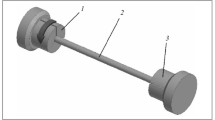Abstract
The effect of the angle of misorientation of substructural elements, structure reversibility during plastic deformation, and the formation of microcracks on the surface of and within a metal on its mechanical properties are examined. It is shown that it is possible to define a degree of degradation (damage) of a metal using the true stress-residual strain diagram.
Similar content being viewed by others
References
L. Bragg, Nature,149, 511 (1942).
N. Petch, J. Iron and Steel Inst.,174, 25 (1953)
C. Ball, Phil. Mag.,2, No. 20, 1011 (1957).
F. Hultgren, Trans. Met. Soc. AIMS,230, 4 (1964).
S. N. Zhurkov, V. I. Betekhtin, and A. I. Petrov, “On the connection between the strength of metals with misoriented mosaic blocks and the size of the crystals,” Fiz.-Khim. Mekh. Mater.,23, No. 6, 1101–1107 (1967).
L. I. Tushinskii, “Optimizing structure to improve the wear resistance of alloys,” in: Physics of Vertical Crack Development in Surface Metals [in Russian], FTI, Akad. Nauk. SSSR (1988), pp. 42–45.
V. I. Trefilov, Yu. V. Mil'man, R. K. Ivashenko, et al., Structure, Texture, and the Mechanical Properties of Deformed Molybdenum Alloys [in Russian], V. I. Trefilova (ed.), Naukova Dumka, Kiev (1983).
A. N. Vergazov, V. A. Likhachev, and V. V. Rybin, “Study of structural fragmentation in molybdenum during active plastic deformation,” Fiz.-Khim. Mekh. Mater.,42, No. 6, 1241–1246 (1976).
I. A. Kelareva, “Passage of shear through a multisided dislocation boundary,” Fiz.-Khim. Mekh. Mater.,19, No. 2, 173–181 (1965).
J. C. M. Li, “Petch relation and grain boundary sources," Trans. AIMS, No. 227, 239–247 (1963).
V. M. Finkel', Z. A. Maslovskaya, and N. K. Doroshenko, “Breaking of dislocation accumulations through large angle boundaries,” Fiz. Tverd. Tela,8, No. 9, 2738–2743 (1966).
R. K. Ivashchenko, V. A. Manilov, V. I. Trefilov, and F. A. Firstov, “Role of cell structure in forming the mechanical properties of chromium,” Fiz. Tverd. Tel.,28, No. 6, 1070–1076 (1969).
L. M. Rybakova, “Misorientation of the substructural elements in polycrystals,” in: Structure and Properties of Materials in a Wide Temperature Range. Scientific-Technical Progress in Machinery Construction [in Russian], MTsNTI, Moscow (1991), Vol. 32, pp. 28–36.
L. M. Rybakova, S. I. Bulichev, V. S. Tumasyan, et al., “Strain aging in the surface layers of low-alloy steel,” Metalloved. Term. Obrab. Metall., No. 11, 32–38 (1990).
V. K. Babich, Yu. P. Gul', and I. E. Dolzhenkov, Strain Aging of Steel [in Russian], Metallurgiya, Moscow (1972).
L. M. Rybakova, L. I. Kuksenova, and S. V. Bosov, “X-ray method for the investigation of structural changes in the thin surface layer of a metal upon fracture,” Zavod. Lab., No. 3, 293–296 (1973).
E. P. Kostyukova and B. M. Rovinskii, “On determining the nature of the substructure in crystals of coarse-grained materials,” Izv. Akad. Nauk. SSSR, Set. Fiz.,26, No. 3, 331–339 (1962).
A. K. Cottrell, Dislocations and Plastic Flow in Crystals [Russian translation], GOSNTI po Chernoi i Tsvetnoi Metallurgii, Moscow (1958).
B. M. Rovinskii and L. M. Rybakova, “Reversibility of plastic deformation during repeated extension and compression,” Fiz.-Khim. Mekh. Mater.,29, No. 5, 1081–1087 (1970).
“Atomic mechanism of fracture,” Materials of the International Conference on the Problems of Fracture, Metallurgiya, Moscow (1963).
V. A. Likhachev, “Investigation of the conditions of change in the micromechanisms of ductile fracture,” Fiz.-Khim. Mekh. Mater.,40, No. 1, 174–179 (1975).
L. M. Rybakova, “Mechanical properties and damage in a plastically deformed metal," Vestn. Mashinostr., No. 8, 32–37 (1993).
Additional information
Institute of Machinery Science. Translated from Metallovedenie i Termicheskaya Obrabotka Metallov, No. 10, pp. 12–17, October, 1994.
Rights and permissions
About this article
Cite this article
Rybakova, L.M. Mechanical properties and substructure of metals. Met Sci Heat Treat 36, 507–513 (1994). https://doi.org/10.1007/BF01398076
Issue Date:
DOI: https://doi.org/10.1007/BF01398076




